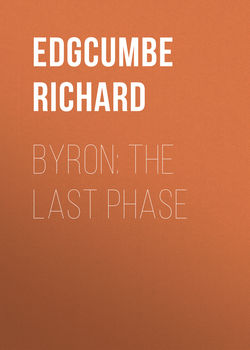Byron: The Last Phase

Реклама. ООО «ЛитРес», ИНН: 7719571260.
Оглавление
Edgcumbe Richard. Byron: The Last Phase
PART I
CHAPTER I
CHAPTER II
CHAPTER III
CHAPTER IV
CHAPTER V
CHAPTER VI
CHAPTER VII
CHAPTER VIII
CHAPTER IX
CHAPTER X
CHAPTER XI
CHAPTER XII
CHAPTER XIII
CHAPTER XIV
CHAPTER XV
CHAPTER XVI
PART II. WHAT THE POEMS REVEAL
PART III ‘ASTARTE’
CHAPTER I
CHAPTER II
CHAPTER III
CHAPTER IV
CHAPTER V
CHAPTER VI
APPENDIX. DR. BRUNO’S REPLY TO FLETCHER’S STATEMENT
Отрывок из книги
‘A large disagreeable city, almost without inhabitants’ – such was the poet Shelley’s description of Pisa in 1821. The Arno was yellow and muddy, the streets were empty, and there was altogether an air of poverty and wretchedness in the town. The convicts, who were very numerous, worked in the streets in gangs, cleaning and sweeping them. They were dressed in red, and were chained together by the leg in pairs. All day long one heard the slow clanking of their chains, and the rumbling of the carts they were forced to drag from place to place like so many beasts of burden. A spectator could not but be struck by the appearance of helpless misery stamped on their yellow cheeks and emaciated forms.
On the Lung’ Arno Mediceo, east of the Ponte di Mezzo, stands the Palazzo Lanfranchi, which is supposed to have been built by Michael Angelo. Here, on November 2, 1821, Lord Byron arrived, with his servants, his horses, his monkey, bulldog, mastiff, cats, peafowl, hens, and other live stock, which he had brought with him from Ravenna. In another quarter of the city resided Count Rugiero Gamba, his son Pietro, and his daughter Countess Teresa Guiccioli. On the other side of the Arno, nearly opposite to Byron’s residence, lived the poet Shelley, with his wife and their friends Edward and Jane Williams.
.....
But we should not be writing about Byron and his foibles eighty-four years after his death, if he had not been wholly different to other men in his views of life. Shortly after his marriage, for no sufficient, or at least for no apparent reason, Byron chose to immolate himself, and took a sort of Tarpeian leap, passing the remainder of his existence in bemoaning his bruises, and reviling the spectators who were not responsible for his fall. One of the main results of this conduct was his separation from his child, for whom he seems to have felt the deepest affection. We find him, at the close of his life, constantly speaking of Ada, ‘sole daughter of his heart and house,’ and prophesying the advent of a love whose consolations he could never feel.
This prophecy was amply fulfilled. It appears that, after Ada’s marriage to Lord King, Colonel Wildman met her in London, and invited her to pay him a visit at Newstead Abbey. One morning, while Ada was in the library, Colonel Wildman took down a book of poems. Ada asked the name of the author of these poems, and when shown the portrait of her father – Phillips’s well-known portrait – which hung upon the wall, Ada remained for a moment spell-bound, and then remarked ingenuously: ‘Please do not think that it is affectation on my part when I declare to you that I have been brought up in complete ignorance of all that concerns my father.’ Never until that moment had Ada seen the handwriting of her father, and, as we know, even his portrait had been hidden from her. When Byron’s genius was revealed to his daughter, an enthusiasm for his memory filled her soul. She shut herself up for hours in the rooms which Byron had used, absorbed in all the glory of one whose tenderness for her had been so sedulously concealed by her mother. On her death-bed she dictated a letter to Colonel Wildman, begging that she might be buried at Hucknall-Torkard, in the same vault as her illustrious father. And there they sleep the long sleep side by side – separated during life, united in death – the prophecy of 1816 fulfilled in 1852:
.....